The first Indian team to win a World Cup at Lord's after '83—a group of street k
Winning a cricket World Cup at Lord's has been a platform for more than just sports for these street children in India


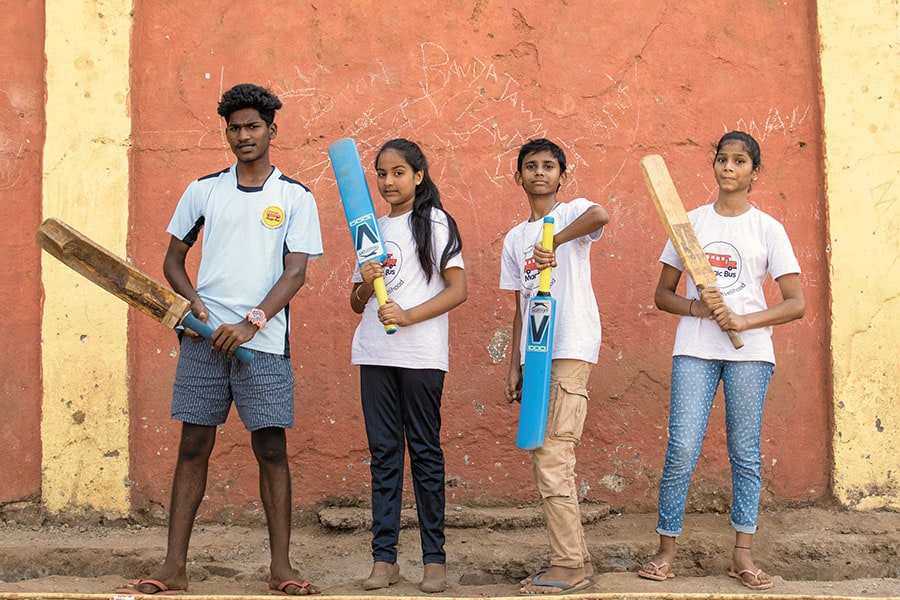 (From left) Mumbai kids Mani Ratinam, Shama Siddiqui, Md Irfan Labbe, and Bhavani Mayavan, who were part of Team India South
(From left) Mumbai kids Mani Ratinam, Shama Siddiqui, Md Irfan Labbe, and Bhavani Mayavan, who were part of Team India South
Image: Himadri Sharma for Forbes IndiaSeventeen-year-old Mani Ratinam is the Jasprit Bumrah of Cheeta Camp, a teeming neighbourhood of slums as far as the eye can go in Mumbai’s Trombay. He’s got the same wiry frame, languid gait, quiet smile and furious pace. “Woh Cheeta Camp ka champion hai [he’s the local champion],” says a 14-year-old neighbour.
Mani isn’t much of a talker himself, and keeps glancing at his watch as the time for his evening game of cricket draws near. He clams up even further in front of his mother. “Mera interview aap bahar lo, mummy ke saamne nahi [take my interview outside, not in front of my mother],” he insists. He won’t give away much, till you bring up cricket and ask him about Mumbai Indians and their IPL win. “Lasith Malinga ka last ball slow tha,” he says, suddenly turning animated and rolling his arm over to bowl an imaginary slower, “koi nahi maar pata [no one could have hit it].”
Mani would perhaps know a thing or two about death-over heroics. Not just in the dusty bowls of Trombay but also at the hallowed portals of the Lord’s in London, the Mecca of cricket, where he hit a six to bring home the inaugural Street Child Cricket World Cup. “It was a wide ball that could have fetched us three runs, and with another over to go, we would still have won. Par usme mazaa nahi aata [it wouldn’t have been fun]. So I hit a six,” says the Class 10 student, who represented India South that beat hosts England in the final.
There’s a flatscreen TV in the single room that Mani shares with his mother, a cleaner in a local school, and three older sisters their father passed away when he was two. But he doesn’t get to watch much cricket, he lets on, if his sisters are around. When it’s time for their TV serials, Mani has to turn to YouTube on his phone. “I watch video tutorials on bowling grips. This,” he says, folding his fingers, “is how Zaheer Khan delivered a knuckle ball.”.jpg) (From left) Paulraj, Nagalakshmi Anguraj, Suryaprakash Kandaiya and Monisha Baskar, the Chennai players who represented Team India South
(From left) Paulraj, Nagalakshmi Anguraj, Suryaprakash Kandaiya and Monisha Baskar, the Chennai players who represented Team India South
Image: P Ravikumar for Forbes IndiaDespite his affinity for bowlers, Mani’s role model is someone who was the stuff of their nightmares. “Sachin Tendulkar. Absolute favourite,” he says. But, once the final runs were scored at the World Cup, his teammate Mohammad Irfan reveals with a toothy grin, Mani took off his shirt, emulating not Tendulkar but his opening partner and former India captain Sourav Ganguly’s victory celebration during the Natwest Trophy final in 2002.
Mani’s batting bluster also gave his skipper, Chennai boy Paulraj Velu, unique bragging rights. Paulraj, who lives with his street vendor parents and two brothers in a plastic shack on a road near the Madras United Club, has now become the first Indian after Kapil Dev to lead his team to a world cup victory at Lord’s. An attacking batsman and the highest scorer of the tournament, the 17-year-old set the tone of his team’s campaign by hitting three consecutive sixes off the first three balls he faced in their opening match against West Indies. “All I wanted was to replicate [Mahendra Singh] Dhoni’s helicopter shots,” he says.
Paulraj, who wants to become a lawyer to help poor innocents, and Mani are among 80 children from eight countries, who travelled to England in April and May this year to take part in the World Cup organised by Street Child United (SCU), a UK-based charity. With multiple expressions of interest in the event from India, SCU invited four NGOs to field two teams: While Team India South comprised children from Magic Bus (Mumbai) and Karunalaya (Chennai), eight children from Kolkata’s Hope Foundation and Save the Children India made up Team India North that narrowly lost out on a semi-final spot to Bangladesh.
*****
The idea of organising a sports tournament to give voice to the marginalised was triggered by a volunteering stint that John Wroe, the CEO of SCU, had in South Africa in 2007. As part of a street child organisation, Wroe would play football with a boy who had been living on the streets for 10 years. “One day, he told me, ‘When people see me on the street, they say I am a street child. When they see me play football, they say I’m a person, just like any of them,” says Wroe. “That’s when I realised sports could change the way the society looks at street children.”.jpg) Paulraj Velu, the captain of India South, poses with his family in Chennai
Paulraj Velu, the captain of India South, poses with his family in Chennai
Image: P Ravikumar for Forbes IndiaThe term SCU uses to define its constituency is not merely ‘street children’, but ‘street-connected children’, to include kids who are dependent on the streets for their livelihood even if they have a home to return to—children of migrant workers, sex workers, those who flee abusive families, for instance. Unicef pegs the number of such children at 100 million worldwide. In India, ‘children in street situations’ constitute a heterogeneous population that makes their count difficult. A census done by Save The Children India in five cities puts their number at 20 lakh. But it’s just the tip of the iceberg.
A number of global movements have previously demonstrated how a vulnerable populace can be kept off malfeasance, and integrated into the mainstream, through cultural or sporting initiatives. El Sistema, a classical music programme started in Venezuela in 1975 by maestro Jose Antonio Abreu to help the country’s children escape poverty, is a classic example. Paddy Upton, the physical trainer of the South African cricket team in the 1990s, participated in a similar sport project in his hometown Cape Town.
Leaving a team led by Hansie Cronje, Upton returned to the city, known for high incidence of crime and gang wars. Every Tuesday and Thursday, he joined a few others to play football with the street kids, and, once done, cooked a meal for them under an abandoned bridge. “It was all casual. But soon the police reported that crime would drop in the area for two days a week. We came to realise that when the kids were playing, they wouldn’t need to drink or do drugs, or commit crime to finance their addiction. They would go home to sleep on a full stomach and feel good about themselves,” he says.
Upton’s story finds resonance halfway across the globe, in the life of Jabir Ali, a 15-year old from Kolkata who would sell incense sticks at traffic signals, and was given to substance abuse. Rescued by the Hope Foundation in July 2014 and sent to de-addiction programmes, Ali would later flee schools in fear of being reprimanded by teachers. Now a Class 7 topper, he was selected for India North as an all-rounder, like his favourite Hardik Pandya.
An event of the scale of a ‘world cup’ was first organised by the SCU in 2010 in Durban for soccer, ahead of the soccer world cup in the country. Since then, two such football world cups have taken place—in Rio in 2014, and Moscow in 2018—to coincide with the professional events in Brazil and Russia. Besides, the SCU also organised a Street Children Olympics in 2016 in Rio, the venue of the Olympic Games .
The colossal impact that these events had in the sub-continent compelled the organisation to turn to cricket. Says Wroe, “In 2016, after the Olympics, the then Indian Minister for Child Welfare Maneka Gandhi promised to provide birth registration and Aadhar cards to all street children. Pakistan undertook its first-ever census of street kids three of its provinces funded child protection training for the police. Someone from the MCC [Marylebone Cricket Club, the owners of Lord’s] emailed me and said if soccer and Olympics could bring about these changes, imagine what cricket could do.”
*****
True to its mantra of equal opportunities, the cricket world cup was drafted into six-a-side matches with two substitutes: Batsmen would retire after scoring 15 and the bowling side would deliver five four-ball overs to allow every player to get an opportunity. This world cup featured mixed-gender teams, ensuring that at any given point, the fielding team had three girls and three boys, and the batting team one each on the pitch. “The issues for girls on the streets are far more severe than that of boys. We wanted to tell the stories of these young women and we wanted the young men to support them,” says Wroe.
What began with mild disdain from the boys in the form of “tui parbi na [you can’t do it]” during practice, soon turned into not just encouragement, but also factoring girls in team strategies. “Once the mingling started, the boys would walk up to me and say she spins the ball well, we’ll get her to start the innings,” says Geeta Venkadakrishnan, director, Hope Foundation. 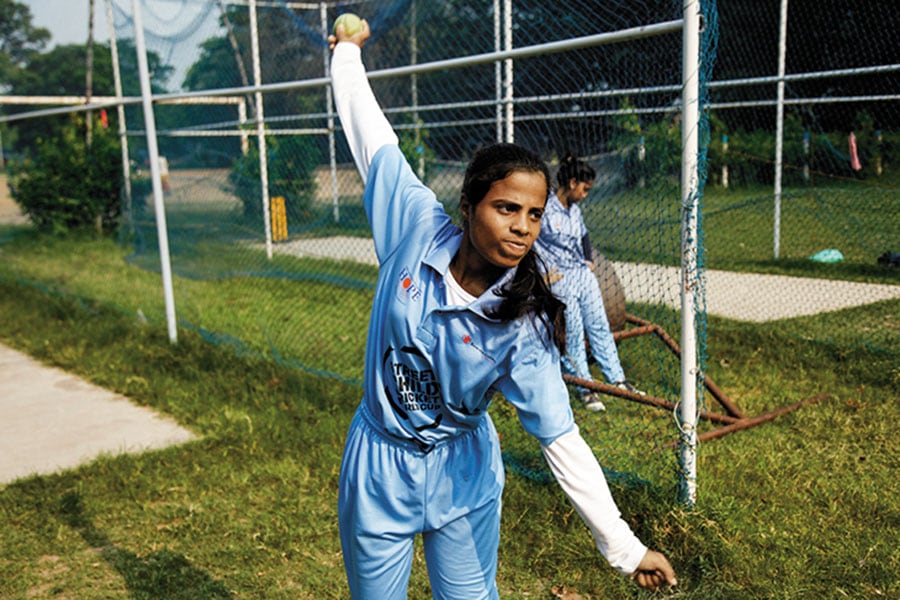 Millie Singh bowls at the nets
Millie Singh bowls at the nets
Image: Subrata Biswas for Forbes IndiaThe inclusivity has fuelled cricketing aspirations in girls too, in the likes of Nagalakshmi Anguraj, 17, who was deserted by her mother when she was young and dumped into a shelter by her paternal grandmother. Having grown up in protection homes, Nagalakshmi wants to become a social worker and rescue abandoned children, but also meet Mithali Raj someday. “If I play well enough, I will ask her if she would give me a chance to play in the national team. Now that I have started playing, even if I make a career out of social work, I will never quit cricket,” says the Chennai girl.
That gender barriers were well and truly broken was evident when Mani, in an aberration from his reticent self, announced: “Women form the pillar in our team. Without the girls, our team is nothing.”
*****
Besides merely sports, the SCU uses these events as an advocacy platform for street children. A recurrent theme that appeared through a Congress and a UN-style General Assembly, where the kids spoke about their aspirations and vocalised their demands, was their invisibility in the eyes of law. Sixteen-year-old Millie Singh, an orphan, was handed over to the Hope Foundation by the courts and had no legal identity till Venkadakrishnan took her guardianship and arranged for a passport. Millie’s problem was highlighted by Lusi Kumari, 14, in a speech at the House of Commons in the UK, where she exhorted lawmakers to give them an identity. “I didn’t have a date of birth and wouldn’t have been able to come to London if it wasn’t arranged for later. Please help us with identification,” she said.
Monisha Baskar lost her father early and her mother is a sweeper. With only a few TVs between the 20-odd families that live on her street in Chennai, watching a cricket match is a rare privilege for the 14-year-old. But that did not stop her from playing football and cricket—“I am the only girl from my locality who is into sports”—as well as representing her team at the General Assembly after the final at Lord’s. “If you respect us, you’ll listen to us, if you listen to us, you’ll protect us,” she said in her extempore speech, highlighting false criminal cases that the police often foists on them. The wheel seems to have finally turned when the local cops promised her mother, who had printed banners on Monisha’s return, that they would stop harassing kids playing on the streets. “These were the very people who would shoo us away,” says Monisha, a fan of Ganguly, and West Indian Dwayne Bravo.
Moumita Saha, advocacy, campaign and communication coordinator, Save The Children, says, “We selected the kids based not only on their physical fitness but also the potential to verbalise the issues dogging them. We were looking for kids who had leadership qualities and could be spokespersons on the global stage.”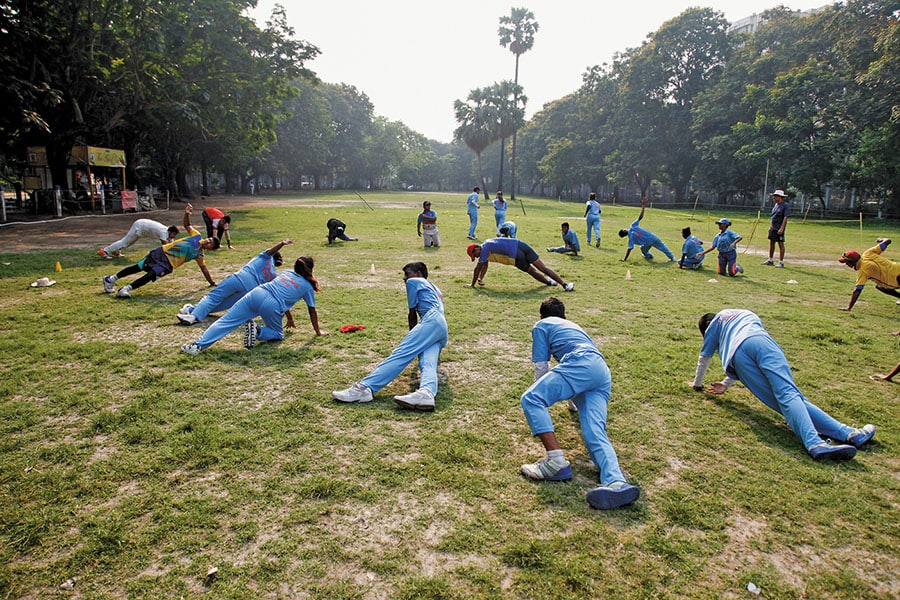 Children from Kolkata practise at an academy
Children from Kolkata practise at an academy
Image: Subrata Biswas for Forbes IndiaMaking the cut was Bhavani Mayavan, resident of a 10 ft x 10 ft hutment in Mumbai’s Cheeta Camp, where she lives with her father, a municipal worker, mother, a domestic help, and three siblings. Playing cricket in the dingy alleys in her neighbourhood had become a predicament for the 15-year-old: Balls would crack open electricity meter boxes to expose wires, adding to fears of electrocution. On the other hand, stepping out of her home in sportswear and heading to the nearby ground would invite snide remarks from the locals. “When we interviewed Bhavani, she was particularly vocal. She said she wanted to change the mindset of her community and become a role model for girls,” says Parvati Pujari, manager, international department, Magic Bus.
Or Anjali Paswan from Kolkata, whose father was murdered when she was two, and brother trafficked. Now in Class 9 and yearning to be either a nurse or an airhostess, Paswan narrates in Bengali, and a smattering of impeccable English, her speech at the General Assembly: “I told them that no child under 18 should have to work for her education or basic needs like food and sanitation. I didn’t see kids staying on the streets of London. I want our government to make shelter homes for kids in our country too, so that they don’t have to live on the street.” The plucky Dhoni fan adds: “We now live in protection homes and are getting a proper education, so it is up to us to help children who are still on the streets.”
The tournament also gave Monisha a masterclass in magnanimity. Having travelled from a hot and humid Chennai, Monisha came down with fever after landing in chilly England before being rescued by her roommate, Sabiya from Team England, who not only offered her woollens but also helped her jump meal queues.
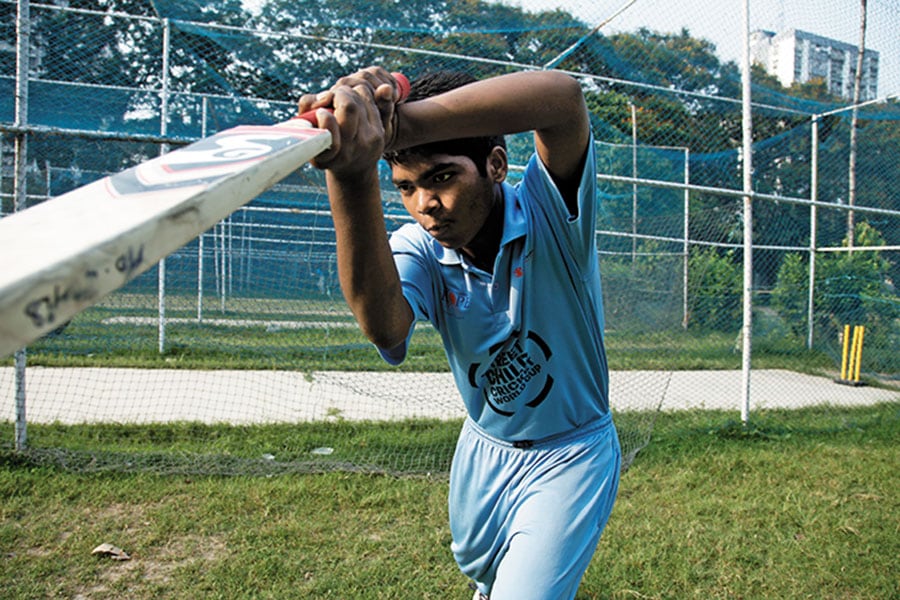 Tarak Sardar, captain of Team India North, knocks around
Tarak Sardar, captain of Team India North, knocks around
Image: Subrata Biswas for Forbes India
For Irfan, the most important takeaway has been the sporting spirit. Crestfallen initially that he was on the bench, he soon picked himself up and started cheering for his teammates. His fervour earned him the fair play award, a plaque that his mother proudly pulls down from the loft every time a visitor wants to have a look, and that has given his father some acceptance of the 15-year-old’s passion: Sketching. Earning ₹300 a day by stitching bags, his father still wants him to take up a job in a bank, but Irfan is now more confident of becoming a cartoonist.
Upton says, “Sports gives these homeless children a sense of belonging. Most of the street kids I have worked with suffer from a low self-esteem. Sports helps to improve that.”
*****
What do these kids bring back from such an experience, and how do they reconcile with the reality of their lives once they’re back? To Matthew Spacie, the founder of Magic Bus, these events don’t work in isolation and are part of a larger structured programme to alleviate their lives. “The children need to be carefully mentored before and after. Because coming back from London to a slum in Mankhurd can be so critical. The idea is [for the event] to become a part of a journey, instead of it being the only thing that happens to them,” says Spacie.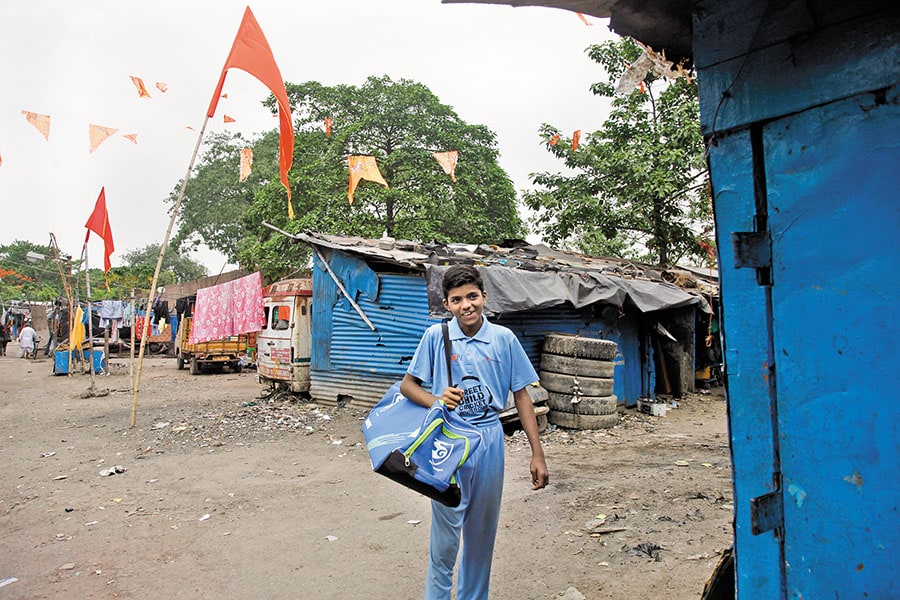 India North member Ayushman Choudhury heads for practice in Kolkata
India North member Ayushman Choudhury heads for practice in Kolkata
Image: Subrata Biswas for Forbes IndiaBut the journey can be rewarding, be it in terms of picking up life skills—from training in the use of Western toilets to adapting to foreign food habits—or new friends. While language was a barrier, most of the kids would make do with gestures. Nagalakshmi fondly recalls Kutrak, her Tanzanian friend, who would dance for her whenever she was upset.
Living in close proximity also gave them a peek into the lives of the street children abroad it showed them how gender discrimination and child labour are as rampant on the streets of Dhaka and Dodoma as they were in Chennai or Kolkata.
“Usually, teams are made to stay together. This time, they mixed it up, letting children from three different countries share a room. A Nepali, Indian and Mauritian boy, who stayed together, couldn’t understand a word of each other but were in tears when they had to leave. That, for me, was the most positive experience,” says Paul Sunder Singh, founder and secretary of Karunalaya.
Wherever they go from here, there’ll always be bit of England in their minds. Tarak Sardar, the skipper of the India North team, wants a London Eye installed next to the Howrah Bridge in his hometown of Kolkata, and Paswan wants the Indian government to have special facilities for the physically-challenged and the elderly, just like in the UK. But, most important, they will always have their biggest takeaway to turn to: As Nagalakshmi puts it succinctly, “Our troubles are all the same. But if we don’t keep those aside, we’ll never be able to look ahead.”
With additional inputs by Divya J Shekhar
First Published: May 31, 2019, 17:14
Subscribe Now